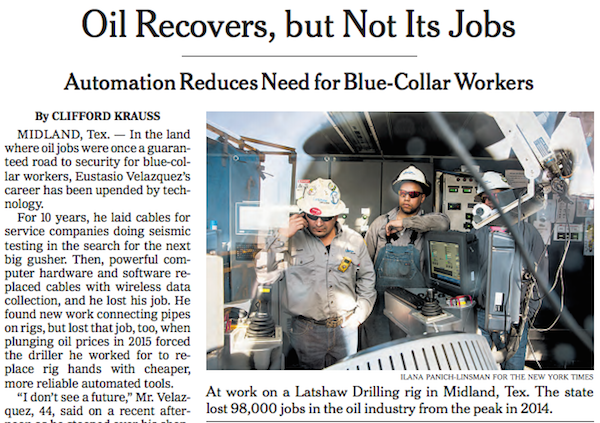
New York Times Reports Automation-Fueled Job Loss in the Oil Patch
02/21/2017
The automation job wrecker got a rare front-page spot on Monday’s New York Times, where the oil industry was the subject: 
Blue-collar worker Eustasio Velazquez, 44, succinctly described the situation of many when he observed, “I don’t see a future. Pretty soon every rig will have one worker and a robot.”
And that one worker will be a tech-trained guy running the oil-extraction machines from a comfy office. The roughnecks have been replaced by robots.
Bloomberg described the changes that automation has brought to the oil industry. The industry representative argued that lower oil prices made automation necessary. Or maybe it’s just more profitable long term.
The employment ecosystem is fundamentally changing because of smart machines, but the conversation has not yet filtered through to Washington. Dallas Mavericks owner Mark Cuban tweeted this week that “Automation is going to cause unemployment and we need to prepare for it,” although he didn’t get into specifics.
There is not a lot that can be done to slow the technology, but the government can at least stop importing immigrant workers who are not needed now and will become even less employable in the automated future. In fact…
Automation Makes Immigration Obsolete
Experts’ projections for a worsening technological unemployment are not hopeful. Oxford researchers forecast in 2013 that nearly half of American jobs were vulnerable to machine or software replacement within 20 years. Rice University computer scientist Moshe Vardi believes that in 30 years humans will become largely obsolete and world joblessness will reach at 50 percent. The Gartner tech advising company believes that one-third of jobs will be done by machines by 2025. Forrester Research Inc. has a more optimistic view, that there will be a net job loss of 7 percent by 2025 from automation — less, but still a serious deficit.
In December, the Houston Chronicle quoted energy analysts‘ estimation that software and robots could reduce the number of oil field workers by 40 percent in the next few years. The Times’ description falls along that line.
Texas Oil Fields Rebound From Price Lull, but Jobs Are Left Behind, New York Times, February 19, 2017The industry is embracing technology, and finding new ways to pare the labor force. But as jobs go away, what of presidential promises to bring them back?
MIDLAND, Tex. — In the land where oil jobs were once a guaranteed road to security for blue-collar workers, Eustasio Velazquez’s career has been upended by technology.
For 10 years, he laid cables for service companies doing seismic testing in the search for the next big gusher. Then, powerful computer hardware and software replaced cables with wireless data collection, and he lost his job. He found new work connecting pipes on rigs, but lost that job, too, when plunging oil prices in 2015 forced the driller he worked for to replace rig hands with cheaper, more reliable automated tools.
“I don’t see a future,” Mr. Velazquez, 44, said on a recent afternoon as he stooped over his shopping cart at a local grocery store. “Pretty soon every rig will have one worker and a robot.”
Oil and gas workers have traditionally had some of the highest-paying blue-collar jobs — just the type that President Trump has vowed to preserve and bring back. But the West Texas oil fields, where activity is gearing back up as prices rebound, illustrate how difficult it will be to meet that goal. As in other industries, automation is creating a new demand for high-tech workers — sometimes hundreds of miles away in a control center — but their numbers don’t offset the ranks of field hands no longer required to sling chains and lift iron.
So while there is a general sense of relief in the oil patch that a recovery is gaining momentum, discussions at company meetings and family kitchen tables are rife with aching worries, especially among those who are middle-aged with no more than a high school education.
Roughly 163,000 oil jobs were lost nationally from the 2014 peak, or about 30 percent of the total, while oil prices plummeted, at one point by as much as 70 percent. The job losses just in Texas, the most productive oil-producing state, totaled 98,000.
Several thousand workers have come back to work in recent months as the price of oil has begun to rise again, but energy experts say that between a third and a half of the workers who lost their jobs are not returning. Many have migrated to construction or even jobs in renewable energy, like wind power …
